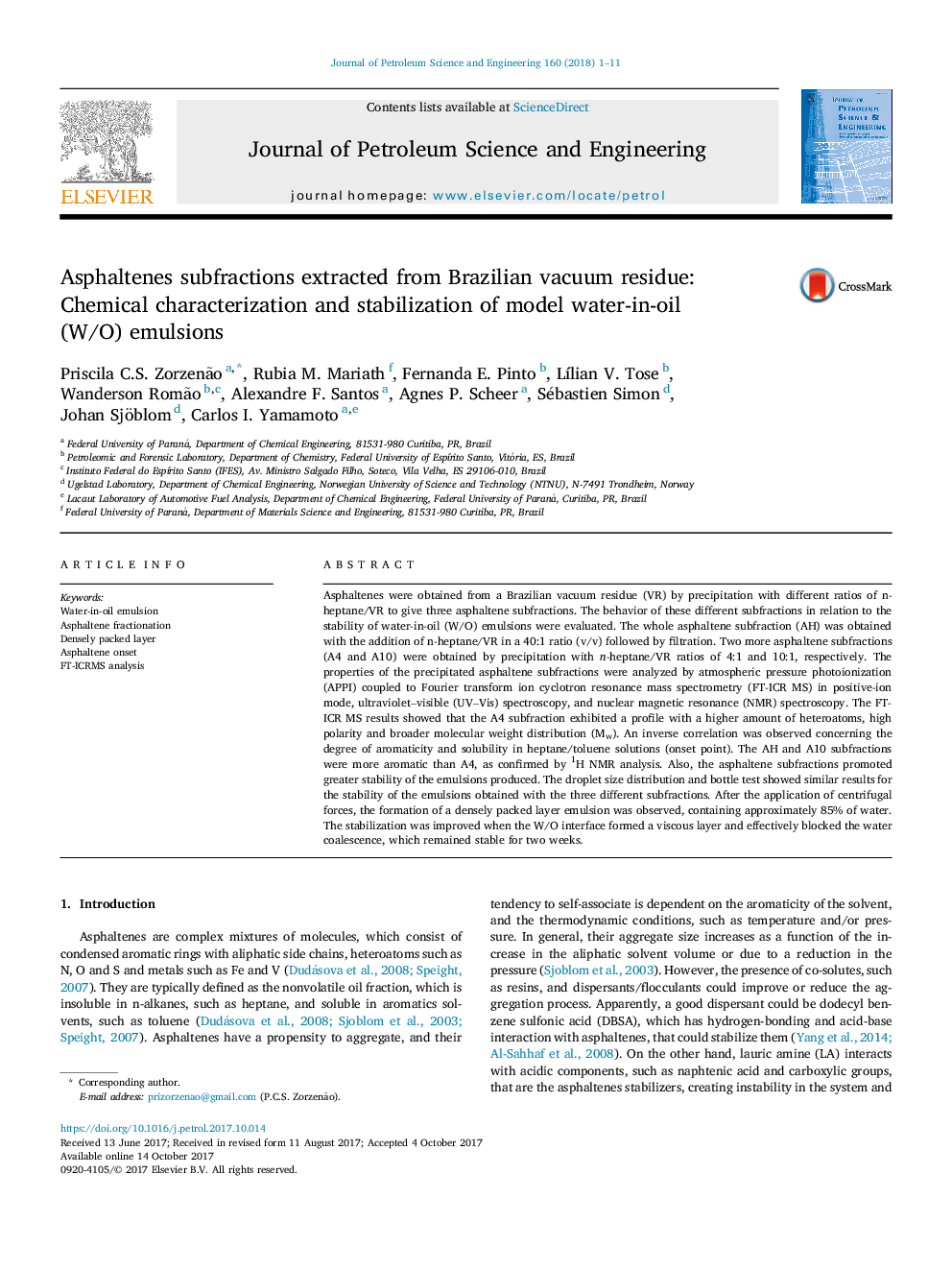| کد مقاله | کد نشریه | سال انتشار | مقاله انگلیسی | نسخه تمام متن |
|---|---|---|---|---|
| 8125430 | 1522781 | 2018 | 11 صفحه PDF | دانلود رایگان |
عنوان انگلیسی مقاله ISI
Asphaltenes subfractions extracted from Brazilian vacuum residue: Chemical characterization and stabilization of model water-in-oil (W/O) emulsions
دانلود مقاله + سفارش ترجمه
دانلود مقاله ISI انگلیسی
رایگان برای ایرانیان
کلمات کلیدی
موضوعات مرتبط
مهندسی و علوم پایه
علوم زمین و سیارات
زمین شناسی اقتصادی
پیش نمایش صفحه اول مقاله

چکیده انگلیسی
Asphaltenes were obtained from a Brazilian vacuum residue (VR) by precipitation with different ratios of n-heptane/VR to give three asphaltene subfractions. The behavior of these different subfractions in relation to the stability of water-in-oil (W/O) emulsions were evaluated. The whole asphaltene subfraction (AH) was obtained with the addition of n-heptane/VR in a 40:1 ratio (v/v) followed by filtration. Two more asphaltene subfractions (A4 and A10) were obtained by precipitation with n-heptane/VR ratios of 4:1 and 10:1, respectively. The properties of the precipitated asphaltene subfractions were analyzed by atmospheric pressure photoionization (APPI) coupled to Fourier transform ion cyclotron resonance mass spectrometry (FT-ICR MS) in positive-ion mode, ultraviolet-visible (UV-Vis) spectroscopy, and nuclear magnetic resonance (NMR) spectroscopy. The FT-ICR MS results showed that the A4 subfraction exhibited a profile with a higher amount of heteroatoms, high polarity and broader molecular weight distribution (Mw). An inverse correlation was observed concerning the degree of aromaticity and solubility in heptane/toluene solutions (onset point). The AH and A10 subfractions were more aromatic than A4, as confirmed by 1H NMR analysis. Also, the asphaltene subfractions promoted greater stability of the emulsions produced. The droplet size distribution and bottle test showed similar results for the stability of the emulsions obtained with the three different subfractions. After the application of centrifugal forces, the formation of a densely packed layer emulsion was observed, containing approximately 85% of water. The stabilization was improved when the W/O interface formed a viscous layer and effectively blocked the water coalescence, which remained stable for two weeks.
ناشر
Database: Elsevier - ScienceDirect (ساینس دایرکت)
Journal: Journal of Petroleum Science and Engineering - Volume 160, January 2018, Pages 1-11
Journal: Journal of Petroleum Science and Engineering - Volume 160, January 2018, Pages 1-11
نویسندگان
Priscila C.S. Zorzenão, Rubia M. Mariath, Fernanda E. Pinto, LÃlian V. Tose, Wanderson Romão, Alexandre F. Santos, Agnes P. Scheer, Sébastien Simon, Johan Sjöblom, Carlos I. Yamamoto,